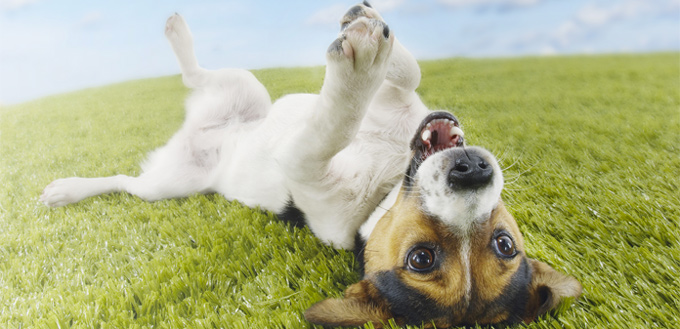Degenerative myelopathy is a disease that affects the dog’s spinal cord. In the early stages, it progresses slowly but increases the pace of degeneration in the later stages.
Unfortunately, there is no known cure for this disease and there is no way you can stop or decrease its progression. Once your dog gets this condition, it has to live with it and maybe eventually die.

That said, you can still give your dog the best care and good quality of life, so it is happy being with you even when the dog is in pain. This is the best help you can do to a suffering companion.
So, here are the different stages of progression for degenerative myelopathy.
Stage I
In the first stage, this condition is hardly visible. This is also one of the reasons why the diagnosis is sometimes delayed.
If your dog is already a senior, it might look it is suffering from arthritis or muscle pain. Sometimes, it might even look like the dog is losing some of its muscle mass, but they are all a part of degenerative myelopathy. In fact, it may be hard to identify degenerative myelopathy from normal arthritis. So, you have to look closely for the following symptoms.
- When your dog’s nails slightly scrape through the ground while walking, it could mean degenerative myelopathy. But, this is quite infrequent and in most cases, easy to miss, unless you watch out every time when your dog gets up and walks.
- If the nails in your dog’s paw grow unevenly, it is a symptom of degenerative myelopathy. Again, this is something that we often overlook while clipping your friend’s paw nails and is not easy to identify.
- A little bit of clumsiness while walking. Though we may think that the dog is not well or has just missed a step, it could be degenerative myelopathy.
- When your dog finds it hard to perform some slightly difficult but regular tasks like climbing the steps.
The above symptoms are clearly hard to notice and they could also be due to other factors such as arthritis or just weakness. But, if you see a combination of these factors and if they seem to happen at regular intervals, it is time to reach out to a vet.
Stage II
In stage II, the symptoms are more distinct and can help you identify that your dog is indeed suffering from degenerative myelopathy. This is also when your dog needs the most care and help from you.
Some of the noticeable symptoms during this phase are:
- The scraping of the dog’s feet in the ground will happen regularly. In fact, it will be a regular aspect that will be hard to miss.
- There is considerable muscle mass, especially in the dog’s thighs. The strength and agility of your dog go down considerably due to the loss of this muscle mass. The dog might even find it difficult to get up to a standing position and it will not be able to climb more than a few steps.
- Coordination also drops considerably. The dog’s hind legs are wobbly and have no balance whatsoever. He will fall often and may not even be able to recover in the latter half of this stage. If your dog has a long tail, it may trip often with its own tail.
- Balance is extremely low and he will fall with just a gentle push.
- The dog will lose sensation in his paws. He may cross his legs and can stumble with his own legs.
- The dog will hardly wag his tail and this is probably the hardest to accept, as a dog owner who is used to see the dog wag his tail happily.
- The dog has no control over his urine or feces and may have “accidents” often.
- The dog has a lot of pain in its lower paws and as a way to cope with it, the dog will walk on the upper part of its toes.

Stage III
This is the last stage of degenerative myelopathy and this is when the dog suffers the most. Many people prefer to euthanize the dog during the latter half of mid-stage or at this stage because it is painful for the dog, both physically and emotionally.
Here are some symptoms that are most profound in this stage:
- The movements of the hind legs and tails are not under the dog’s control. This is why you’ll often see awkward movement or kicks for no apparent reason. The dog cannot control any of these movements.
- Finally, the hind part of the leg will become paralyzed and the dog will not be able to move or get up from that point on.
- There is no coordination or balance for the dog. It cannot walk by itself and sometimes, may not even be able to stand. Your dog absolutely needs your help to stand up and walk, otherwise, it might injure itself.
- The weakness will slowly spread to its shoulders too, and the dog will soon become paralyzed all over the body.
- Towards the end, the dog will become very weak and it will start having organ failures. It is best to euthanize your dog before it gets to this stage to avoid a lot of pain for the dog.
How to Care for Your Dog?
Having a dog with degenerative myelopathy can be painful for the dog and you. It is not easy to see your dog lying in one place writhing in pain. When it stops wagging its tail, that’s likely to be the tipping point for many dog owners and they break down from here. Many even choose to euthanize the dog to put an end to its suffering.
During stage I and the early part of stage II, here are some things you can do to make your dog feel better.
- First off, understand what your dog is going through. The pain can be excruciating and the dog will be confused because it doesn’t know what is going on. Also, when it loses its physical independence, it can be scary and devastating for the dog.
- Be patient and care for your dog. This is the wrong time to abandon it.
- The constant scraping of the paws against the ground can make the paws sore. Many times, the dog will have cuts and wounds too. You can consider putting on a pair of socks for dogs or booties to protect their paws. There is a lot of debate on whether you cover your dog’s paws because the dog already has only a limited feeling. If you add another layer, this feeling will decrease, even more, thereby making it difficult for your dog to walk. That said, it is completely up to you.
- Another option is to put a lot of mats inside the house, so the dog gets traction. It will slip less often and will be able to balance itself better. However, this option may not always be practical, especially if you live in a multi-story house or if the entire house is not carpeted. It can also get quite expensive, so think about these aspects too.
- Consider using harnesses and slips to give your dog some support while walking. This support can be particularly helpful when the dog is wobbling on its legs and is unable to get coordination and balance.
- There are many types of dog harnesses available today such as a combination harness and hind-life harness. They come in many shapes and sizes as well. So, pick the one that best suits the needs of your dog.
- If your dog is too out of balance, think about getting him dog wheelchairs and mobility carts that will give him more independence to walk around. However, these can be expensive, so think about it, especially because you will have to eventually euthanize your dog sooner or later.
- Have ramps, so your dog can get into your car. This can be a worthwhile investment because the dog needs some fresh air and maybe even a change of location to get some distraction from its pain.
- As ironical as it may sound, exercise is an important aspect of degenerative myelopathy because it helps your dog to keep its muscles active and maybe move for some more time. Swimming and short walks are good forms of exercise for dogs suffering from degenerative myelopathy.
- Veterinary care and physical care are other things that your dog needs from you.
Related Post: Best Dog Ramps
Above everything, give your dog a lot of care, love, and affection because it may not be around much longer.
In short, degenerative myelopathy is a disease that has no known cure. It could lead to paralysis in the end and may result in organ failures too. During this time, stay strong and give plenty of support for your dog to help it cope with this disease.
Sources:
- Dr. Jennifer Michaels, Degenerative Myelopathy, MSPCA–Angell
- Dr. Beth Boudreau, Degenerative Myelopathy, Texas A&M College of Veterinary Medicine & Biomedical Sciences
- Degenerative Myelopathy, MU Veterinary Health Center








Hello,
I have a 15 and 3 month old Shiba Innu, he has vestibular disease and I believe he also may have Degenerative Myelopathy. Given his age, our doctor has not done any tests to confirm this. He has had some accidents in the house, especially when sleeping at night. But, he does know when he has to go and will get up to go outside. Recently though, he had a vestibular attach and when it subsided, we noticed his back legs were not working as well. He is now afraid to go through the doggie door and we have had to carry him outside when we think he needs to go potty. Also, he has no eyes, as he had Glaucoma. He had one eye removed about 4 years ago and the second about 2 years ago. What are the signs and stages of Degenerative Myelopathy? Not sure what what we should do.
I’ve been doing a lot of research on DM and all the other sites say that DM does NOT cause pain.